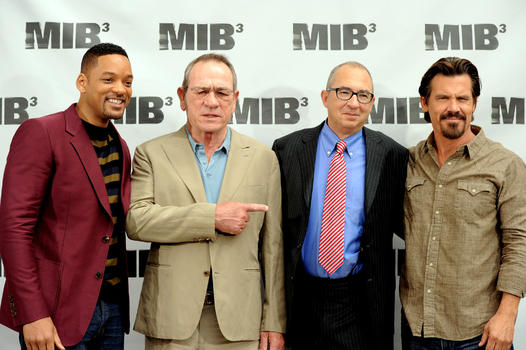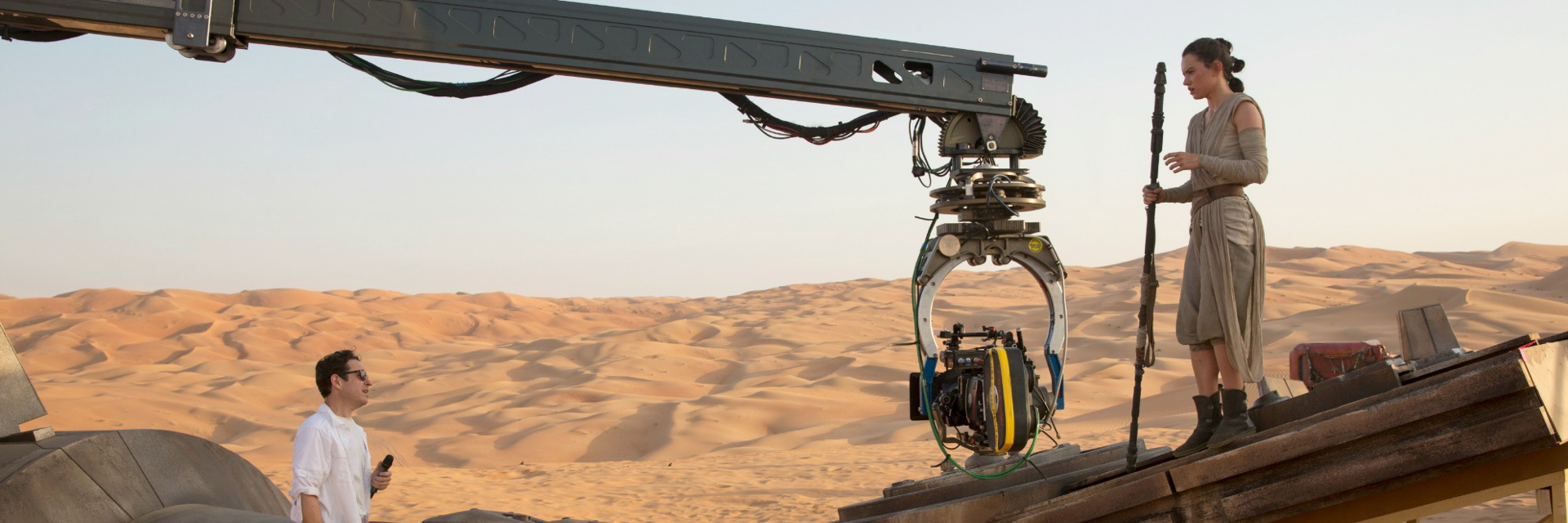“Men in Black 3” director Barry Sonnenfeld says James Cameron’s looking-through-a-window-into-a-world approach to the use of 3D makes sense because, “that is exactly the definition of Jim Cameron.
‘If it were up to Jim, he would live seven miles underwater in the Mariana trench – it’s about living underwater and viewing the world through a window,” Sonnenfeld said.
“In my case, I don’t even swim.”

Sonnenfeld, who chose to shoot “MiB3” on film and convert it from 2D-to-3D during post-production with the help of L.A.-based digital 3D and visual effects studio Prime Focus World and stereographer Corey Turner, prefers using 3D as a tool and a character in the movie to invite the audience into each scene. For instance, in a simple dialogue-driven scene in a diner, the images of actors Will Smith and James Brolin are both in front of the screen.
Something appears to be in front of the screen in more than two-thirds of the scenes of “MiB3,” according to Sonnenfeld.
“I don’t understand why you would shoot a 3D movie and push it behind the screen and keep the audience out of the movie,” he said. “ ‘Avatar’ and ‘Hugo’ are beautiful 3D movies but most of the scenes are at the screen or behind it. Sometimes it feels like you’re observing rather than participating.”
In fact, with many inferior 3D movies and poor theatrical exhibition in some cases – “The only thing that can kill 3D is exhibitors, if they project it at lower brightness or have a projector out of sync, prompting the customer to never go back to pay extra for 3D again.” — Sonnenfeld thinks TV may be what keeps 3D going, particularly because the transmitted light of TV screens makes the image much brighter even with dark glasses.
 In the meantime, in Sonnenfeld’s preferred medium of film, he was so pleased with the Prime Focus conversion job on “MiB3” that he is ready to produce 3D conversions of the original “Men in Black” and “MiB2,” if “MiB3” plays well enough in China where the first two films never opened theatrically. Sonnenfeld already has high praise for Sony Pictures Entertainment and Columbia TriStar Motion Picture marketing and distribution chairman Jeff Blake for allowing him to make two different 3D theatrical masters for “MiB3,” one to play in countries like the USA where more than 70% of screens use the RealD 3D projection/silver screen system with more reflective light when viewed straight on with passive 3D glasses, but which is darker from the sides. The other master is being used in most other countries where the XpanD active shutter glasses 3D system is more prevalent and features roughly the same brightness no matter the viewers’ position.
In the meantime, in Sonnenfeld’s preferred medium of film, he was so pleased with the Prime Focus conversion job on “MiB3” that he is ready to produce 3D conversions of the original “Men in Black” and “MiB2,” if “MiB3” plays well enough in China where the first two films never opened theatrically. Sonnenfeld already has high praise for Sony Pictures Entertainment and Columbia TriStar Motion Picture marketing and distribution chairman Jeff Blake for allowing him to make two different 3D theatrical masters for “MiB3,” one to play in countries like the USA where more than 70% of screens use the RealD 3D projection/silver screen system with more reflective light when viewed straight on with passive 3D glasses, but which is darker from the sides. The other master is being used in most other countries where the XpanD active shutter glasses 3D system is more prevalent and features roughly the same brightness no matter the viewers’ position.
The “MiB3” Blu-ray 3D version has already been transferred using a modified version of the XpanD theatrical master “because a TV set is the same brightness edge-to-edge,” Sonnenberg said. Prime Focus is currently developing a version of its trademarked View-D theatrical 3D conversion process optimized for 3D TV, mobile media and advertising markets.
As a cinematographer (“Blood Simple,” “Big,” “Misery”) and a director (“The Addams Family,” “Get Shorty”), Sonnenfeld’s decision to use conversion on his first 3D film instead of shooting in native 3D was an easy and obvious choice after he shot a series of tests using two different 3D digital camera rigs versus an Arriflex 2D film camera that was later converted (only digital cameras can shoot 3D).
First of all, Sonnenfeld was very pleased with the results of the Prime Focus View-D conversion process that has been employed on major movies such as “Transformers: Dark of the Moon,” “Star Wars: Episode One – The Phantom Menace,” “Harry Potter and the Deathly Hallows: Part 2,” and “The Chronicles of Narnia: The Voyage of the Dawn Treader.
Prime Focus, which originated in Mumbai in 1997 under co-founders and current CEO Namit Malhotra and Chief Creative Officer Merzin Tavaria, now has offices in India, Canada, and the U.K.
“I think the 3D (in “MiB3”) looks better than almost any 3D movie I’ve ever seen,” Sonnenfeld said. “It immerses you better.”
He still prefers the look of film over digital, particularly with effects and the alien make-up, which he felt began to stand out with more of a shine and a plastic appearance in digital.
Another big objection to the digital 3D rig option was the limitations and delays.
“The added layers of technicians takes forever to change lenses and line it up. The on-set pace of shooting in native 3D was painfully slow and didn’t allow me the pace I am used to working at on set, especially with a comedy feature.”
Additionally, “If you shoot in native stereo, you have to choose and shoot the inter-ocular separation in advance and (it’s difficult to change) in post.”
By controlling the 3D conversion in post, Sonnenfeld was able to adjust the layers of depth. For instance, in certain shots filmed with digital 3D, he said Will Smith’s ears might seem inordinately far back from his nose. In converting during post-production, he
compressed Will Smith’s face to have his ears closer to his nose while still showing depth behind him.
Furthermore, Sonnenfeld created a gradual increase in the depth leading up to scenes with a big 3D effect, such as Will Smith’s character falling off the Chrysler building. “I gradually prepared the eyes of the audience for the additional depth” to avoid too big of a visual jolt, he said. Working with Sony ImageWorks and Turner, whom Sonnenfeld calls the “best stereographer around,” he also tweaked the image by creating a shadow to darken Smith during his fall. “It let your brain know to only look in the foreground.”
“That scene “would have looked a lot worse in native 3D,” he said.
The size and restrictions of the 3D camera rigs are also an issue for Sonnenfeld. He says the stereo camera has a super-wide matte box to allow for inter-ocular stereo. Since Sonnenfeld shoots with a 21mm lens, he said that in a scene, for example, in which a character is holding a gun in his out-stretched hand and the shot calls for the camera to push past the gun, the 3D camera dolly cannot go past the hand into the face because the matte box hits the gun. The only option is to use a 40mm or 50 mm lens and move the camera further back from the actor, which is not the shot that Sonnenfeld wants.
Having spent $12 mil. to $15 mil. on the 2D-to-3D conversion process, Sonnenfeld says, “Most movies would be better off converting.”
In addition to estimating costs are lower when everything is factored in – including post-production tweaks for realignment – Sonnenfeld said the process is quick in post. “We’d still be shooting if we went native,” he said.
But he admits that the choice between shooting native and converting in post comes down to personal preference.
For Sonnenfeld, the adjustment may be easier to shoot in 2D with a post-production 3D conversion in mind since he always shoots in a 3D-friendly way anyway, meaning that he uses wide angle lenses, shoots on an axis, and seldom pans.
Either way, he believes filmmakers must utilize 3D more effectively. It wasn’t the concept of conversion that sunk the poster-movie for bad 3D, “Clash of the Titans,” he said, suggesting it would have been equally bad if shot in native 3D. Sonnenfeld maintains that conversion is the way to go with the possible exception of movies featuring lots of explosions with particulates coming towards the lens.
— By Scott Hettrick

Wow. Sonnenfeld very clearly does not know what he’s talking about. $12-15 million for conversion? He should have talked to Spider-Man guys, who did the new one in native 3D — on a 2D budget and on a 2D schedule. Can’t change inter-ocular separation in post when shooting native? Sure you can!
“I don’t understand why you would shoot a 3D movie and push it behind the screen and keep the audience out of the movie.” Sheesh. You’re not keeping audience out of the movie by using positive parallax; you do it to avoid eye strain. Negative parallax, i.e. stuff coming out of the screen, forces our eyes to function in a way they are not used to, i.e. converge to a distance closer than the distance they are focusing to. Sure, viewing negative parallax becomes easier with practice but if you haven’t watched lots of 3D movies, don’t be surprised to come out of MIB3 with aching eyes.
I will see MIB3, certainly, but in the format it was envisioned and shot in: 2D. Right now I’m off to see Prometheus, a proper 3D movie.
I like Barry Sonnenfeld but he’s a hit or miss director (hits–MIB, Get Shorty – misses–Wild Wild West). He’s never shot a 3D movie and never tried. Who the $#^& is he to say what someone as knowlegeable as James Cameron knows or not about 3D. Every one of Cameron’s films have been a success and he’s quite simply proven himself as a leading authority on 3D, visual effects, editing, producing, and directing. 3D post conversion just plain sucks. As Petri says “$12-$15 million for conversion”–how about hire a better screenwriter for that money instead of paying for a cheap gimmick that NO ONE cares about. How about making better films instead of tricking out a mediocre one? I will not see this movie and if I did I sure as hell WON’T see it in FAUX-D. 3D is a fad and nothing more. Nothing curdles my blood more than a filmmaker who should know better saying he’s going to post convert all his previous films. Good luck with that. You won’t make a cent from me!
I am afraid Barry Sonnenfeld doesn’t have a clue what he is talking about where 3D is concerned. Using Harry Potter and the Deathly Hallows: Part 2 as an example of what conversion can accomplish demonstrates that beautifully, it was a terrible, highly inconsistent conversion!
As for his questionable idea to use negative parallax in two thirds of the scenes, I strongly suggest people avoid MIB3 3D at all costs becuase I would be very surprised if it does anything other than rip their eyes right out of their heads and give them thumping migraines in the process.
Very sad! Another 2D film maker playing with 3D without having any sort of extended learning curve in which to hone the necessary understanding or skills to do so.
If I was serious about movies, I would find this article very depressing.
I saw a few 3D movies and then found a list of which of them were filmed in 3D.
As I looked through the list it all made sense, and I felt cheated.
The movie Sanctum wasn’t much to look at, but at least what there was to see, looked right because it was FILMED WITH 3D CAMERAS !!
If you’re going to create a 3D movie, it doesn’t take Einstein to realise that YOU NEED TO FILM IT WITH 3D CAMERAS !!